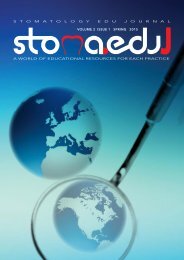Stomatology Edu Journal 1/2014
Create successful ePaper yourself
Turn your PDF publications into a flip-book with our unique Google optimized e-Paper software.
cariology<br />
primary role in protecting the pulp-dentine complex<br />
(14). When using this technique, the practitioner can<br />
arrest the acute progression of the carious lesion,<br />
by modifying the cariogenic environment. The soft<br />
demineralized dentine is changing in most cases,<br />
into a dentine with increased consistency and brownyellow<br />
or dark-brown appearance. The efficiency<br />
of the „stepwise” excavation technique was also<br />
assessed after 6-12 months by other authors (15).<br />
The clinical changes of demineralized dentine<br />
were associated with a high reduction of bacterial<br />
contamination. After 6 months, in 90% of the cases<br />
the consistency of demineralized dentine increased,<br />
while in 20% of the cases there was a complete<br />
sterilization of demineralized dentine. Using a<br />
standardized scale of consistency and color changes,<br />
some authors found the remineralisation of dentine<br />
in 94% of the cases after 2-19 months following the<br />
„stepwise” excavation technique (16). The clinical<br />
and radiographical changes of the demineralized<br />
dentine, following indirect pulp capping with<br />
Ca(OH) 2 and zinc-oxyde-eugenol, after an interval of<br />
6-7 months, were assessed by different authors (4).<br />
The affected dentine became hard dentine in 80%<br />
of the treated teeth, while 16,67% of teeth presented<br />
demineralized dentine with medium consistency.<br />
In the same study, only 3,3% cases were associated<br />
with total absence of remineralisation processes.<br />
The „stepwise” excavation technique is included<br />
in the category of new operatory treatment<br />
options for dental caries, but some authors claim<br />
potential failures in the long-term follow up of the<br />
treated teeth (17). Performing a critical review of<br />
23 studies focused on this technique, the authors<br />
sustain the use of this technique on a large scale<br />
for the treatment of deep acute dental caries. A<br />
similar critical review of such studies concluded<br />
that the „stepwise” excavation technique presents<br />
positive results in the long-term, regarding the<br />
vitality preservation of the pulp-dentine complex<br />
(18).<br />
Conclusion<br />
1. The remineralisation of the affected dentine<br />
from acute carious lesions performed with zincoxide-eugenol<br />
or with calcium-hydroxide liner and<br />
glassionomer cement in „stepwise” excavation<br />
technique was present in 80% of the cases.<br />
2. After 6 months, 90% of the acute carious lesions<br />
treated with calcium-hydroxide liner and zinc-oxideeugenol<br />
in the „stepwise” excavation technique<br />
presented dentine remineralisation.<br />
3. The „stepwise” excavation technique is an<br />
efficient approach in the treatment of acute dental<br />
caries maintaining pulp vitality in 90-100% of the<br />
cases.<br />
Bibliography<br />
1. Oliveira EF, Carminatti G, Fontanella V, Maltz M.The<br />
monitoring of deep caries lesions after incomplete dentine<br />
caries removal: results after 14-18 months. Clin Oral<br />
Investig. 2006;10(2):134-139.<br />
2. Leksell E, Ridell K, Cvek M, Mejare I. Pulp exposure after<br />
stepwise versus direct complete excavation of deep carious<br />
lesions in young posterior permanent teeth. Endod Dent<br />
Traumatol. 1996;12(4):192-196<br />
3. Ricketts D. Management of the deep carious lesion and the<br />
vital pulp dentine complex. Br Dent J. 2001;191(11):606-<br />
610.<br />
4. Maltz M, Oliveira EF, Fontanella V, Carminatti G. Deep<br />
caries lesions after incomplete dentine caries removal:40-<br />
month follow-up study. Caries Res. 2007;41(6):493–496<br />
5. Duque C, Negrini TD, Sacono NT, Spolidorio DM, de<br />
Souza Costa CA, Hebling J. Clinical and microbiological<br />
performance of resin-modified glass-ionomer liners after<br />
incomplete dentine caries removal. Clin Oral Investig.<br />
2009;13 (4):465-471<br />
6. Manton D. Partial caries removal may have advantages<br />
but limited evidence on restoration survival. Evid Based<br />
Dent. 2013;14(3):74-75<br />
7. Ricketts D, Lamont T, Innes NP, Kidd E, Clarkson JE.<br />
Operative caries management in adults and children. Br<br />
Dent J. 2001;191(11):606-610.<br />
8. Studervant CM. The art and science of operative dentistry.<br />
3rd ed. St Louis:Mosby,1995<br />
9. Goldberg M, Six N, Decup F. Bioactive molecules and the<br />
future of pulp therapy. Am J Dent. 2003;16(1):66–76.<br />
10. Iovan Gianina. Diagnosis and Management of Patients<br />
with High Caries Activity. Apollonia Press, 2002<br />
11. Banerjee A, Kidd EAM, Watson TF. In vitro evaluation<br />
of five alternative methods of carious dentine excavation.<br />
Caries Res. 2000;34 (2):144-150.<br />
12. Banerjee A, Kidd EAM, Watson T F. Scanning electron<br />
microscopic observations of human dentine after mechanical<br />
caries excavation. J Dent. 2000;28 (3):179-186.<br />
13. Braut A, Kollar EEEJ, Mina M. Analysis of the odontogenic<br />
and osteogenic potentials of dental pulp in vivo using a Col1a1-<br />
2.3-GFPtransgene. Int J Dev Biol. 2003;47 (4):281-292.<br />
14. Banerjee A., Watson T, Kidd E.A.M. Carious dentine excavation<br />
using Carisolv gei:a quantitative, autofluorescence assess¬ment<br />
using scanning microscopy. Caries Res. 1999;33(4):313<br />
15. Carneiro F.C, Teixeira F, Guimaraes L, Dias K, Naclanovsky<br />
P. Clinical comparison between chemo-mechanical and hand<br />
instruments caries removal. J Dent Res. 2000;79 (5):295<br />
16. Fure S, Lingstrom P, Birkhed D. Evaluation of Carisolv(TM)<br />
for the Chemo-Mechanical Removal of Primary Root Caries.<br />
Caries Res. 2000;34(3):275-280.<br />
17. Love RM, Jenkinson HF. Invasion of dentinal tubules by<br />
oral bacteria. Crit Rev Oral Biol Med. 2002;13(2):171-183.<br />
18. Perdigäo J, Cardoso PEC, Lopes M, Moura SK, Geraldeli<br />
S, Cardoso. JMS. Effect of carisolv on the hybrid layer. J.<br />
Dent. Res. 2000;79 (1 suppl):537<br />
16 Stoma.eduJ (<strong>2014</strong>) 1 (1)




